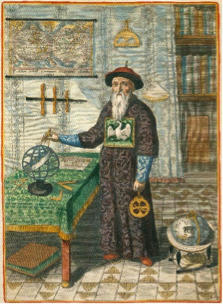Intercultural Clothing: Prof. Menegon Delivers ‘Ricci Lecture’ at Saint Louis University
In the afternoon of October 3rd, Professor Eugenio Menegon delivered the Fall “Ricci Lecture” at St. Louis University (SLU), St. Louis, Missouri, as part of the “Matteo Ricci Speakers Series: the Jesuits, Christianity, China, and the Intercultural Experience” sponsored by the Center for Medieval and Renaissance Studies, the Departments of History and Theological Studies, and several other centers and programs at SLU (http://matteoricci.slu.edu/).
 This talk focused on the intercultural experience of clothing and bodily practices in early modern China. Entitled “The Habit that Hides the Monk: Missionary Fashion Strategies in Early Modern China,” the lecture mapped the changing wardrobe, hairdo and ‘fashion statements’ of early modern missionaries in China, from the Ming to the Qing period (17th-19th centuries). Since the arrival of the first Jesuits in China in the late Ming period (1580s), one of the most visible forms of “going native” was the adoption of Chinese clothing and hairstyle (see images of missionaries in Ming and Qing attires). Dressing like the Chinese was not a choice, as foreigners residing within China had to adapt to local dress codes and bodily practices. Only in native garb could missionaries enter and circulate in the Chinese empire, and truly become “local agents.” The age-old adage “the habit does not make the monk” needs revisiting in this case: in the China mission, clothing was actually a way to “hide the monk,” i.e. the missionary’s religious identity, while opening myriad venues into late imperial Chinese society, within a culture constrained but also shaped, like early modern Europe, by sumptuary laws and cultural taboos about clothes and the body.
This talk focused on the intercultural experience of clothing and bodily practices in early modern China. Entitled “The Habit that Hides the Monk: Missionary Fashion Strategies in Early Modern China,” the lecture mapped the changing wardrobe, hairdo and ‘fashion statements’ of early modern missionaries in China, from the Ming to the Qing period (17th-19th centuries). Since the arrival of the first Jesuits in China in the late Ming period (1580s), one of the most visible forms of “going native” was the adoption of Chinese clothing and hairstyle (see images of missionaries in Ming and Qing attires). Dressing like the Chinese was not a choice, as foreigners residing within China had to adapt to local dress codes and bodily practices. Only in native garb could missionaries enter and circulate in the Chinese empire, and truly become “local agents.” The age-old adage “the habit does not make the monk” needs revisiting in this case: in the China mission, clothing was actually a way to “hide the monk,” i.e. the missionary’s religious identity, while opening myriad venues into late imperial Chinese society, within a culture constrained but also shaped, like early modern Europe, by sumptuary laws and cultural taboos about clothes and the body.
 After delivering this well-attended lecture introduced by the chair of History Professor Charles Parker (Global Early Modern History and Dutch Golden Age), and by organizers Professors Filippo Marsili (Early Chinese History) and Pauline Lee (Chinese Philosophy and Religion), Menegon spent two days doing research in the famous “Knights of Columbus Vatican Film Library” at SLU (http://lib.slu.edu/special-collections/collections/vfl). The Library contains thousands of reels of precious manuscripts on the history of missions from several archives in Rome, Seville and Barcelona. Menegon also met graduate students in a seminar taught by Professor Zhao Ma (modern Chinese cultural history) in the Department of East Asian Languages and Cultures at Washington University in Saint Louis, to discuss field research and archival resources for dissertation writing in Chinese studies.
After delivering this well-attended lecture introduced by the chair of History Professor Charles Parker (Global Early Modern History and Dutch Golden Age), and by organizers Professors Filippo Marsili (Early Chinese History) and Pauline Lee (Chinese Philosophy and Religion), Menegon spent two days doing research in the famous “Knights of Columbus Vatican Film Library” at SLU (http://lib.slu.edu/special-collections/collections/vfl). The Library contains thousands of reels of precious manuscripts on the history of missions from several archives in Rome, Seville and Barcelona. Menegon also met graduate students in a seminar taught by Professor Zhao Ma (modern Chinese cultural history) in the Department of East Asian Languages and Cultures at Washington University in Saint Louis, to discuss field research and archival resources for dissertation writing in Chinese studies.
In the below photograph, Professor Filippo Marsili, who teaches early imperial Chinese history in SLU’s Department of History and was one of the SLU organizer, stands with Professor Menegon in front of a splendid wooden statue of the Buddhist goddess Guanyin (Song dynasty, 10th century CE) in the St. Louis Art Museum.


![IMG_4119[9]](/history/files/2016/10/IMG_41199-636x539.jpg)